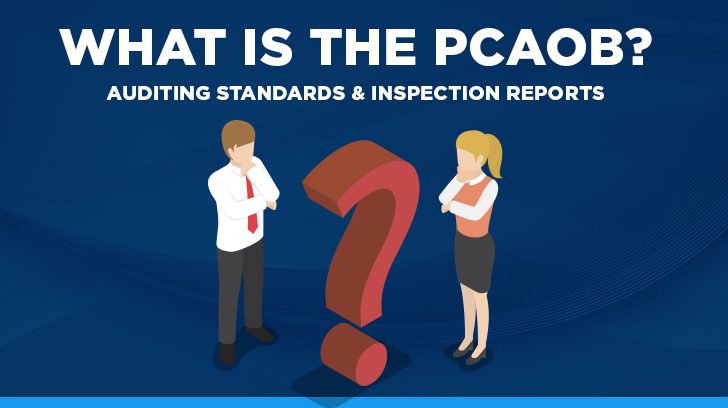You may have heard the terms PCAOB, PCAOB audit, or PCAOB accounting.You hear it a lot, but what does PCAOB stand for or what is the PCAOB?
What is the PCAOB?
The PCAOB is an acronym for the Public Company Accounting Oversight Board. The PCAOB is a regulatory board that oversees the audits of public companies.
The PCAOB is board comprised of five members appointed by the SEC. Each board member serves full-time for five-year terms. While members of the PCAOB may have a variety of backgrounds, two members must be Certified Public Accountants.
Board members are supported by over 800 staffers in a number of departments including Economic and Risk Analysis, Registration and Inspections, and Enforcement and Investigations. So what exactly do all these people do?
PCAOB History
The PCAOB was created by Congress in 2002 as part of the Sarbanes-Oxley Act (SOX) that was passed in response to a series of accounting scandals (e.g., Enron, Worldcom, etc.) to provide better oversight of the auditing industry. The auditing industry self-policed itself before the formation of the PCAOB. However, this approach seemed to be failing the public in the early 2000s.
The PCAOB reports to the Securities and Exchange Commission (SEC) which is charged with the responsibility of protecting investors and maintaining the US securities markets. The PCAOB’s mission and vision statements highlight the aims of their organization:
Mission: “The PCAOB is a nonprofit corporation established by Congress to protect investors and the public interest by promoting informative, accurate, and independent audit reports and to oversee the audits of public companies and broker-dealers.”
Vision: “The PCAOB seeks to be a model regulatory organization. Using innovative and cost-effective tools, the PCAOB aims to improve audit quality, reduce the risks of auditing failures in the U.S. public securities market and promote public trust in both the financial reporting process and auditing profession.” (Source)
PCAOB vs. AICPA (American Institute of Certified Public Accountants)
What is the difference between the AICPA and PCAOB? While closely linked, it is important to understand the similarities and differences between AICPA and PCAOB. The first difference between the two is their type of organizational structure. The PCAOB is a nonprofit corporation and the AICPA is a professional member association.
Both the AICPA and PCAOB are related to the accounting/audit industry. However, their roles are very different. The AICPA is a professional association of accounts and the PCAOB is responsible for monitoring accountants and accounting firms. Both entities are responsible for guidance to the audit and account field. The AICPA created standards that guide accounting professionals. The PCAOB has adopted some of the AICPA’s standards and applied them to public accounting firms.
Another contrast between the two is the scope or each entity. The PCAOB deals specifically with the limited scope of public accounting firms and the audits of public companies. The AICPA provides guidance across a spectrum of accounting services that it members perform for a variety of companies.
What does the PCAOB do? Four Key Activities

1) PCAOB Registration
The PCAOB registers public accounting firms. In order to monitor, the PCAOB needs to know who the firms are. All firms performing financial audits of publicly registered companies must register with the PCAOB. Currently, there are 1,793 firms registered.

2) PCAOB Auditing Standards
The PCAOB board dictates the professional auditing standards that registered auditing firms must use. These standards are utilized to monitor accounting firms. Prior to the PCAOB, standards were set by the AICPA. The PCAOB has largely adopted the AICPA’s auditing standards, added its own, and reorganized the standards to bring them together in a single, integrated numbering system. Please refer to the PCAOB’s website for a full listing of all the standards.
The PCAOB Independence Rules and the Professional Code of Conduct are PCAOB rules that are worth highlighting. The PCAOB adopted the AICPA Professional Code of Conduct (Code). The Code is often referred to as their Independence standards. The Code’s requirements include the integrity, objectivity, and ethical standards that CPA practitioners should adhere to in order to best serve the public.
A CPA or CPA firm’s first duty is to serve the public–not the client. The Code establishes guidelines to help CPAs’ from losing their independence. It provides guidance and examples of relationships and activities that would threaten one’s actual or perceived independence. An example is an auditor who has financial interests in an audit client or close relationships with personnel in key positions within the client’s organization. The Code explains the actions that a firm or individuals may take to eliminate or reduce threats to independence. Efforts taken to ensure independence should be documented so firms can demonstrate their efforts to remain independent. The AICPA’s Professional Code of Conduct can be found here.

3) PCAOB Inspection Reports
The PCAOB performs inspections to evaluate firms’ compliance with the standards mentioned earlier. The PCAOB’s inspections focus on firms that audit 100 or more public companies each year. The PCAOB inspects firms that audit fewer than 100 public companies at least once every three years. The PCAOB stated that the inspections will focus on areas of considered higher risk. These areas include internal control over financial reporting, assessing and responding to risks of material misstatement, and accounting estimates.
A risk-based approach is employed by the PCAOB to selects audit engagements to review. The goal of these inspections is to determine if there are errors in how an accounting firm performed its audit procedures and documentation and if there are adequate quality controls in place within the audit firm. If the PCAOB determines that there was not sufficient evidence to support the auditor’s opinion, audit deficiencies are reported in the inspection report that is published on the PCAOB website.

4) Enforcement
Finally, as a result of the inspections, if the board determines a serious violation has occurred, an enforcement hearing could be conducted. The PCAOB can impose sanctions and fines to firms or individual auditors. A recent example is the SEC/PCAOB issuing a $50 million to KPMG for misconduct including the revision of work papers to reduce the likelihood of receiving findings from a PCAOB inspection.
Summary
To summarize, the main goals of the PCAOB are to monitor the audit firms, in order to restore and maintain investors and the public’s trust in the field, which took a big hit with the aforementioned accounting scandals. The PCAOB also focuses on promoting and enforcing high professional standards to improve the quality of the audit services offered by the registered firms.
Please click the following links to learn more about the services provided by Linford & Co: SOC 1, SOC 2, HIPAA audits, Royalty Audits, FedRAMP.
This article was originally published on June 21, 2017, and updated on August 14, 2019.

Isaac Clarke is a partner at Linford & Co., LLP. He began his career with Ernst & Young in 2003 where he developed his audit expertise over a number of years. Isaac specializes in and has conducted numerous SOC 1 and SOC 2 examinations for a variety of companies—from startups to Fortune 100 companies. Isaac enjoys helping his clients understand and simplify their compliance activities. He is attentive to his clients’ needs and works meticulously to ensure that each examination and report meets professional standards.




